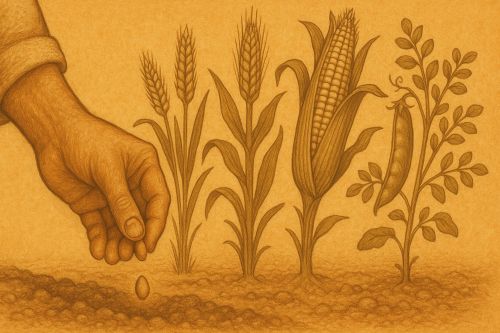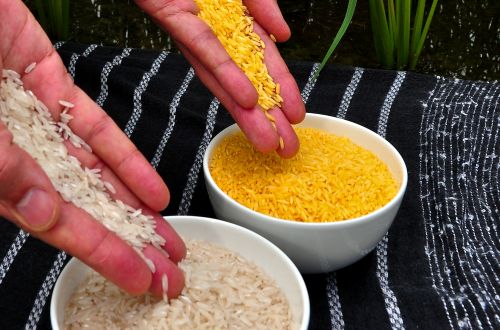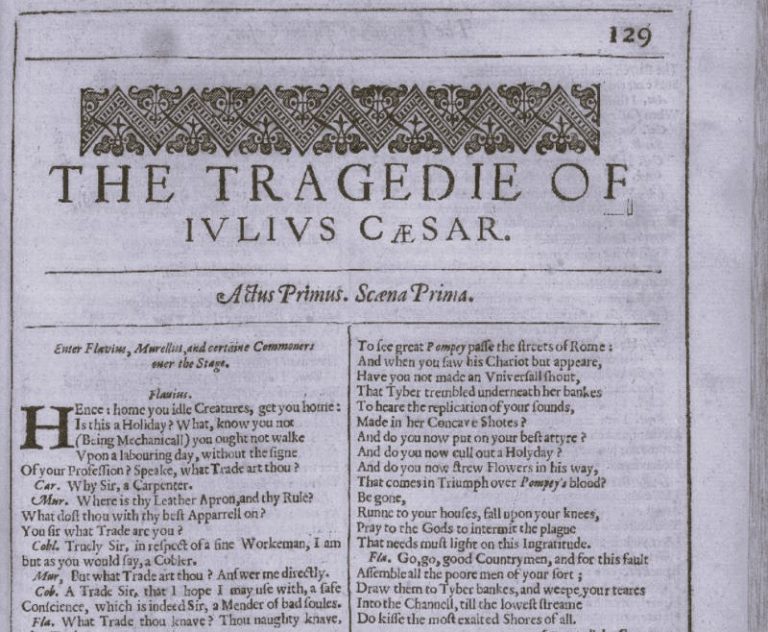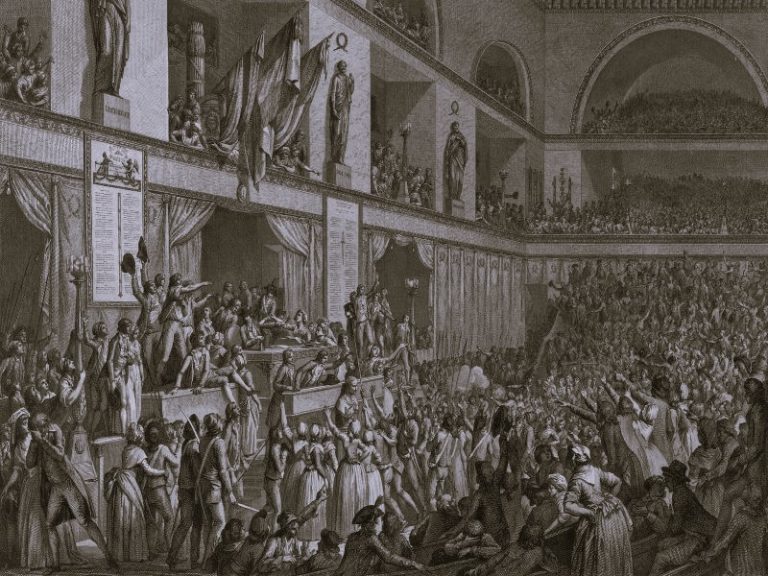

Did people in the ancient and medieval worlds genetically modify crops? If we mean deliberate alteration of hereditary traits, the answer is yes.

By Matthew A. McIntosh
Public Historian
Brewminate
Introduction: The Question of Genetic Modification
When the term “genetic modification” appears in contemporary debate, it usually evokes images of laboratories, microscopes, and crops engineered with precision tools like CRISPR. Yet the deliberate reshaping of plant heredity is far older than the modern age. From the dawn of agriculture in the Fertile Crescent to the gardens of medieval monasteries, humans have intervened in the genetic destiny of crops. What differed was not the intent but the means.
To call ancient practices “genetic modification” risks anachronism, for no one in antiquity or the Middle Ages could see, let alone manipulate, DNA. Yet to deny their profound genetic impact would also be misleading. By preserving seeds from the most desirable plants, hybridizing varieties, and grafting fruit trees, premodern farmers altered genomes as surely as today’s scientists, though on a slower, generational scale.
The historian must therefore tread carefully: the story is not one of rupture between old and new but of continuity, with methods changing across time while the human desire to shape nature remained constant.
Ancient Foundations of Crop Modification
Selective Breeding and Domestication

Picture a Neolithic farmer in the Fertile Crescent. At harvest, she sets aside seeds from wheat whose stalks held firm, refusing to shatter in the field. Season after season, this simple act transforms the plant itself. What began as wild einkorn, fragile and difficult to process, becomes a cultivated wheat with durable ears and larger grains.1
Such selective breeding was deliberate, though not scientific in the modern sense. Farmers noticed which plants thrived, tasted better, or yielded more, and those became the foundation for the next generation. Over centuries, these decisions accumulated into profound genetic change. By the Bronze Age, the crops of Mesopotamia looked little like their wild ancestors.
The transformation of maize tells the story even more dramatically. Its precursor, teosinte, bore hard kernels locked in stone-like cases. Through sustained human intervention, early Mesoamerican farmers produced the maize cob, with rows of soft, exposed kernels. Modern maize could not survive without cultivation, a living testimony to the depth of ancient modification.2
Hybridization and Early Observation
Selective breeding was not the only method. Farmers experimented with crossing varieties, sometimes intentionally, sometimes by chance. Grapevines, barley, and legumes show evidence of such hybridization. Though the underlying mechanisms were unknown, the results were striking enough to be noted and recorded.
Theophrastus, writing in the fourth century BCE, described grafting and plant crosses in his Enquiry into Plants, observing that “plants too have their minglings.”3 His language reveals both curiosity and awe: an awareness that plants could be persuaded into new forms, even if the “how” remained mysterious. What matters for history is that such experimentation was systematized, repeated, and transmitted, a proto-scientific tradition built on patient empirical practice.
Medieval Practices and Agricultural Experimentation
Monastic Gardens as Laboratories of Selection

In medieval Europe, agricultural innovation often flourished within monasteries. Cloister gardens were not only places of meditation but also sites of experimentation. Monks saved seeds from the most productive wheats or the hardiest beans, gradually shaping varieties suited to their local climates. Careful observation, combined with record-keeping, made monastic gardens into quiet engines of genetic change.
These efforts rarely carried the grandeur of discovery. They were embedded in routine, tied to cycles of prayer and harvest. Yet over centuries, they yielded resilient landraces — distinct strains of crops adapted to their regions. A monastery’s rye in northern Europe might differ genetically from that of a Mediterranean abbey, each shaped by human selection and environmental demand.
Islamic Agronomy and Knowledge Transmission
Meanwhile, in the Islamic world, agricultural scholarship reached extraordinary levels of sophistication. Ibn al-‘Awwam’s Book on Agriculture (12th century) offered detailed instructions on cultivating hundreds of plants, emphasizing grafting as a way of “joining their souls together.”4 His descriptions were at once practical and poetic, capturing the sense that human hands could coax new potential from living things.
These works circulated widely, influencing Islamic Spain and later Latin Christendom. They reveal a culture that viewed plants not as fixed entities but as malleable, responsive to careful intervention. Such writings served as intellectual bridges, carrying knowledge from antiquity into medieval practice.
Landraces and Regional Adaptation
Beyond monasteries and treatises, millions of anonymous farmers shaped crops through everyday choices. By consistently replanting from the healthiest or most abundant harvests, they created landraces, localized crop varieties genetically tuned to soil, climate, and pest pressures.
These landraces, often overlooked by grand historical narratives, represent some of humanity’s most enduring agricultural achievements. They carried the genetic memory of centuries of adaptation, ensuring that medieval communities could survive the vagaries of climate and famine.
Ancient and Medieval Versus Modern GMOs

The contrast with modern GMOs is not in purpose but in method. Ancient and medieval farmers worked with whole organisms, steering populations through gradual shifts. Modern scientists intervene at the level of the gene, isolating specific traits and inserting them directly into a crop’s DNA.
Yet the continuity cannot be ignored. The maize cob and Golden Rice differ in technology, but both embody humanity’s drive to remake plants in its own image. Where ancient farmers worked over centuries, modern geneticists compress the same logic into a single experiment. Both belong to the same long story of human ingenuity.
Conclusion: Continuity in Transformation
In a quiet monastery garden around the year 1100, a monk bends to examine a row of wheat. He saves a pouch of seeds from the strongest stalks, never knowing that his choices will echo through centuries. The varieties he preserves may one day merge into the strains that feed modern Europe. The continuity is invisible to him, yet it is real, a thread binding his hand to the bread of the future.
Did people in the ancient and medieval worlds genetically modify crops? If we mean deliberate alteration of hereditary traits, the answer is yes. They lacked microscopes and gene-editing tools, but they possessed observation, patience, and above all necessity. Hunger sharpened their experiments, and survival was their laboratory.
The historian must emphasize continuity: crop genomes have always been human artifacts, sculpted across millennia by hands seen and unseen. The wheat that sustains us, the rice that feeds half the world, the maize that anchors modern diets, all are the products of ancient modification.
Modern biotechnology did not invent the impulse to transform plants. It accelerated it. The laboratory of the Neolithic village, the cloistered garden, and today’s research institute are chapters in the same story: the long, tangled history of humanity’s bid to master the seeds of survival.
Appendix
Footnotes
- Daniel Zohary, Maria Hopf, and Ehud Weiss, Domestication of Plants in the Old World, 4th ed. (Oxford: Oxford University Press, 2012), 28–45.
- John Doebley, Bruce S. Gaut, and Brandon D. Smith, “The Molecular Genetics of Crop Domestication,” Cell 127, no. 7 (2006): 1309–1321.
- Theophrastus, Enquiry into Plants, trans. A. Hort (Cambridge, MA: Harvard University Press, 1916), Book II.
- Ibn al-‘Awwam, Kitab al-Filaha (The Book on Agriculture), trans. J. A. Banqueri (Madrid, 1802), 201–206.
Bibliography
- Doebley, John, Bruce S. Gaut, and Brandon D. Smith. “The Molecular Genetics of Crop Domestication.” Cell 127, no. 7 (2006): 1309–1321.
- Ibn al-‘Awwam. Kitab al-Filaha (The Book on Agriculture). Translated by J. A. Banqueri. Madrid, 1802.
- Theophrastus. Enquiry into Plants. Translated by A. Hort. Cambridge, MA: Harvard University Press, 1916.
- Zohary, Daniel, Maria Hopf, and Ehud Weiss. Domestication of Plants in the Old World. 4th ed. Oxford: Oxford University Press, 2012.
Originally published by Brewminate, 08.26.2025, under the terms of a Creative Commons Attribution-NonCommercial-NoDerivatives 4.0 International license.


